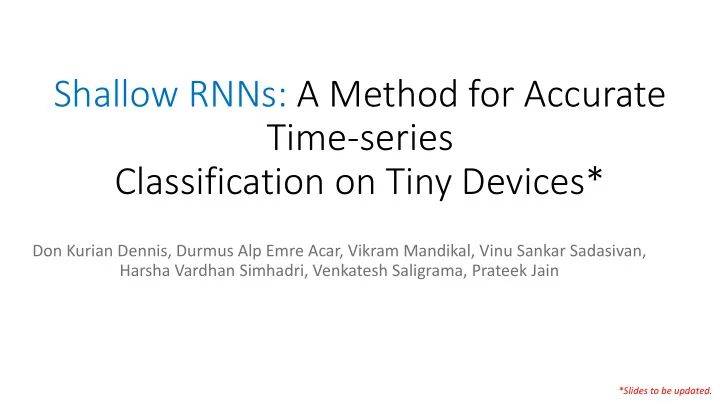

Shallow RNNs: A Method for Accurate Time-series Classification on Tiny Devices* Don Kurian Dennis, Durmus Alp Emre Acar, Vikram Mandikal, Vinu Sankar Sadasivan, Harsha Vardhan Simhadri, Venkatesh Saligrama, Prateek Jain *Slides to be updated.
Outline • Introduction • Background • Shallow RNNs • Results
Introduction • Time series classification: • Detecting events in a continuous stream of data. • Data partitioned into overlapping windows (sliding windows). • Detection/Classification performed on each window.
Introduction • Time Series on Tiny Devices: • Resource scarscity (few KBs of RAM, tiny processors) • Cannot run standard DNN techniques. • Examples: • Interactive cane for people with visual impairment [24]: • Recognizes gestures coming as time-traces on a sensor. 32kB RAM, 40MHz Processor. • Audio-keyword classification on MXChip: • Detect speech commands and keywords. 100MHz processor, 256KB RAM.
Background • How to solve time series problem on tiny devices • RNNs: • Good fit for time series problems with long dependencies, • Smaller models, but no parallelization [28, 14], requires O(T) time. Small but too Slow! • CNNs: • Can be adapted to time series problems. • Higher parallelization [28, 14] but much larger working RAM. Fast but too big!
Shallow RNN - ShaRNN Parallelization Small Size Compute Reuse
Shallow RNN - ShaRNN • Hierarchical collection of RNNs organized at two levels. • Output of first layer is the input of second layer. • 𝑦 ":$ data is split into bricks of size 𝑙 .
Shallow RNN - ShaRNN • ℛ (") RNN is applied to each brick: (") : ℛ (") outputs. • 𝜑 * • ℛ (") bricks: • Operate completely in parallel, • Fully shared parameters.
Shallow RNN - ShaRNN • 𝑙 is hyperparameter: • Controls inference time. • ℛ (") bricks on 𝑙 length series • ℛ (+) bricks on , - length series , • Overall 𝑃( - + k) inference time. • If 𝑙 = 𝑃( 𝑈) : • Overall time is 𝑃 𝑈 instead of O(T)
Results - Datasets • Our method is able to achieve similar or better accuracy compared to baselines in all but one datasets. • Different model sizes (different hidden-state sizes) -> numbers in bracket, • MI-ShaRNN reports two numbers for the first and the second layer. • Computational cost (amortized number of flops required per data point inference) for each method. • MI refers to method of [10] which leads to smaller models and it is orthogonal to ShaRNN.
Results - Deployment • Accuracy of different methods vs inference time cost (ms). • Deployment on Cortex M4: • 256KB RAM and 100MHz processor, • The total inference time budget is 120 ms. • Low-latency keyword spotting (Google-13).
Demo Video Here: dkdennis.xyz/static/sharnn-neurips19-demo.mp4
Thank you!
Recommend
More recommend